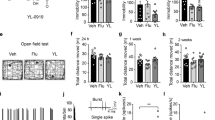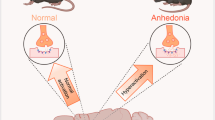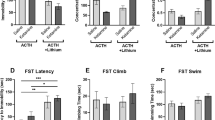Abstract
YL-0919 has been identified as a novel dual 5-HT1A partial agonist and serotonin reuptake inhibitor. In the current study, we demonstrated that YL-0919 produced prominent antidepressant-like and anxiolytic-like effects in a chronic unpredictable stress (CUS) rat model. Male SD rats were exposed to CUS for 5 weeks; YL-0919 (1.25 and 2.5 mg/kg) or a positive control fluoxetine (Flx, 10 mg/kg) was orally administered daily. YL-0919 or Flx treatment significantly increased the sucrose preference rate, the locomotor activity in an open field test (OFT), the latency to feed in a novelty-suppressed feeding test (NSFT), and both the percentage of time spent in the open arms and the number of entries into the open arms in an elevated plus-maze test. YL-0919 or Flx treatment significantly suppressed the serum levels of ACTH and corticosterone in CUS-exposed rats. Additionally, YL-0919 or Flx treatment significantly enhanced the levels of cAMP, the expression of phosphorylated cAMP response element-binding protein (pCREB) and brain-derived neurotrophic factor (BDNF) in the hippocampus of CUS-exposed rats. Similar to Flx, YL-0919 treatment significantly enhanced the dendritic complexity, and increased the number of dendritic nodes as well as the spine length and number of branch nodes in the hippocampal pyramidal neurons of CUS-exposed rats. Overall, our results reveal that YL-0919 suppresses the HPA axis and exerts antidepressant-like and anxiolytic-like effects in CUS-exposed rats, which are associated with the enhanced cAMP signaling and hippocampal dendritic complexity.
Similar content being viewed by others
Log in or create a free account to read this content
Gain free access to this article, as well as selected content from this journal and more on nature.com
or
References
Kessler RC, Berglund P, Demler O, Jin R, Koretz D, Merikangas KR, et al. The epidemiology of major depressive disorder: results from the National Comorbidity Survey Replication (NCS-R). JAMA 2003; 289: 3095–105.
Lee S, Tsang A, Zhang MY, Huang YQ, He YL, Liu ZR, et al. Lifetime prevalence and inter-cohort variation in DSM-IV disorders in metropolitan China. Psychol Med 2007; 37: 61–71.
Shen YC, Zhang MY, Huang YQ, He YL, Liu ZR, Cheng H, et al. Twelve-month prevalence, severity, and unmet need for treatment of mental disorders in metropolitan China. Psychol Med 2006; 36: 257–67.
Trivedi MH, Rush AJ, Wisniewski SR, Nierenberg AA, Warden D, Ritz L, et al. Evaluation of outcomes with citalopram for depression using measurement-based care in STAR*D: implications for clinical practice. Am J Psychiatry 2006; 163: 28–40.
Penn E, Tracy DK . The drugs don't work? antidepressants and the current and future pharmacological management of depression. Ther Adv Psychopharmacol 2012; 2: 179–88.
Nutt DJ . The neuropharmacology of serotonin and noradrenaline in depression. Int Clin Psychopharmacol 2002; 17 Suppl 1: S1–12.
Shelton RC, Tomarken AJ . Can recovery from depression be achieved? Psychiatr Serv 2001; 52: 1469–78.
Khan A . Vilazodone, a novel dual-acting serotonergic antidepressant for managing major depression. Expert Opin Investig Drugs 2009; 18: 1753–64.
Citrome L . Vilazodone for major depressive disorder: a systematic review of the efficacy and safety profile for this newly approved antidepressant - what is the number needed to treat, number needed to harm and likelihood to be helped or harmed? Int J Clin Practice 2012; 66: 356–68.
Reed CR, Kajdasz DK, Whalen H, Athanasiou MC, Gallipoli S, Thase ME . The efficacy profile of vilazodone, a novel antidepressant for the treatment of major depressive disorder. Cur Med Res Opin 2012; 28: 27–39.
Portella MJ, de Diego-Adelino J, Puigdemont D, Perez-Egea R, Alvarez E, Artigas F, et al. Pindolol augmentation enhances response outcomes in first depressive episodes. Eur Neuropsychopharmacol 2009; 19: 516–9.
Sim-Selley LJ, Vogt LJ, Xiao R, Childers SR, Selley DE . Region-specific changes in 5-HT1A receptor-activated G-proteins in rat brain following chronic buspirone. Eur J Pharmacol 2000; 389: 147–53.
Czeh B, Perez-Cruz C, Fuchs E, Flugge G . Chronic stress-induced cellular changes in the medial prefrontal cortex and their potential clinical implications: does hemisphere location matter? Behavioural Brain Res 2008; 190: 1–13.
Trivedi MH, Fava M, Wisniewski SR, Thase ME, Quitkin F, Warden D, et al. Medication augmentation after the failure of SSRIs for depression. N Engl J Med 2006; 354: 1243–52.
Banasr M, Duman RS . Glial loss in the prefrontal cortex is sufficient to induce depressive-like behaviors. Biol Psychiatr 2008; 64: 863–70.
Willner P, Towell A, Sampson D, Sophokleous S, Muscat R . Reduction of sucrose preference by chronic unpredictable mild stress, and its restoration by a tricyclic antidepressant. Psychopharmacology (Berl). 1987; 93: 358–64.
Gray JA, Lalljee B . Sex differences in emotional behaviour in the rat: correlation between open-field defecation and active avoidance. Animal Behav 1974; 22: 856–61.
Chen HX, Jin ZL, Zhang LM, Xue R, Xu XD, Zhao N, et al. Anti-depressant-like activity of YL-0919: a novel combined selective serotonin reuptake inhibitor and 5-HT1A receptor agonist. PLoS One 2013: 8: e83271.
Zhang LM, Wang XY, Zhao N, Wang YL, Hu XX, Ran YH, et al. Neurochemical and behavioural effects of hypidone hydrochloride (YL-0919): a novel combined selective 5-HT reuptake inhibitor and partial 5-HT1A agonist. Br J Pharmacol 2017; 174: 769–80.
Banasr M, Valentine GW, Li XY, Gourley SL, Taylor JR, Duman RS . Chronic unpredictable stress decreases cell proliferation in the cerebral cortex of the adult rat. Biol Psychiatry 2007; 62: 496–504.
Banasr M, Duman RS . Glial loss in the prefrontal cortex is sufficient to induce depressive-like behaviors. Biol Psychiatry 2008; 64: 863–70.
Ma M, Ren Q, Yang C, Zhang JC, Yao W, Dong C, et al. Adjunctive treatment of brexpiprazole with fluoxetine shows a rapid antidepressant effect in social defeat stress model: Role of BDNF-TrkB signaling. Sci Rep 2016; 6: 39209.
Willner P, Towell A, Sampson D, Sophokleous S, Muscat R . Reduction of sucrose preference by chronic unpredictable mild stress, and its restoration by a tricyclic antidepressant. Psychopharmacology (Berl) 1987; 93: 358–64.
Gray JA, Lalljee B . Sex differences in emotional behaviour in the rat: correlation between open-field defecation and active avoidance. Anim Behav 1974; 22: 856–61.
Warner-Schmidt JL, Duman RS . VEGF is an essential mediator of the neurogenic and behavioral actions of antidepressants. Proc Natl Acad Sci U S A 2007; 104: 4647–52.
Masood A, Nadeem A, Mustafa SJ, O'Donnell JM . Reversal of oxidative stress-induced anxiety by inhibition of phosphodiesterase-2 in mice. J Pharmacol Exp Ther 2008; 326: 369–79.
Ren Q, Ma M, Ishima T, Morisseau C, Yang J, Wagner KM, et al. Gene deficiency and pharmacological inhibition of soluble epoxide hydrolase confers resilience to repeated social defeat stress. Proc Natl Acad Sci U S A 2016; 113: E1944–52.
Ren Q, Zhang JC, Ma M, Fujita Y, Wu J, Hashimoto K . 7,8-Dihydroxyflavone, a TrkB agonist, attenuates behavioral abnormalities and neurotoxicity in mice after administration of methamphetamine. Psychopharmacology 2014; 231: 159–66.
Berton O, McClung CA, Dileone RJ, Krishnan V, Renthal W, Russo SJ, et al. Essential role of BDNF in the mesolimbic dopamine pathway in social defeat stress. Science 2006; 311: 864–8.
Golden SA, Covington HE, 3rd, Berton O, Russo SJ . A standardized protocol for repeated social defeat stress in mice. Nat Protoc 2011; 6: 1183–91.
Qin X, Liu Y, Zhu M, Yang Z . The possible relationship between expressions of TRPC3/5 channels and cognitive changes in rat model of chronic unpredictable stress. Behav Brain Res 2015; 290: 180–6.
Flores G, Alquicer G, Silva-Gomez AB, Zaldivar G, Stewart J, Quirion R, et al. Alterations in dendritic morphology of prefrontal cortical and nucleus accumbens neurons in post-pubertal rats after neonatal excitotoxic lesions of the ventral hippocampus. Neuroscience 2005; 133: 463–70.
Martinez-Tellez R, Gomez-Villalobos Mde J, Flores G . Alteration in dendritic morphology of cortical neurons in rats with diabetes mellitus induced by streptozotocin. Brain Res 2005; 1048: 108–15.
Sholl DA . Dendritic organization in the neurons of the visual and motor cortices of the cat. J Anat 1953; 87: 387–406.
Wang JW, David DJ, Monckton JE, Battaglia F, Hen R . Chronic fluoxetine stimulates maturation and synaptic plasticity of adult-born hippocampal granule cells. J Neurosci 2008; 28: 1374–84.
Papp M, Moryl E, Willner P . Pharmacological validation of the chronic mild stress model of depression. Eur J Pharmacol 1996; 296: 129–36.
Willner P . Validity, reliability and utility of the chronic mild stress model of depression: a 10-year review and evaluation. Psychopharmacology 1997; 134: 319–29.
Sun JD, Liu Y, Yuan YH, Li J, Chen NH . Gap junction dysfunction in the prefrontal cortex induces depressive-like behaviors in rats. Neuropsychopharmacology 2012; 37: 1305–20.
Fawcett J, Clark DC, Scheftner WA, Gibbons RD . Assessing anhedonia in psychiatric patients. Arch Gen Psychiatry 1983; 40: 79–84.
McEwen BS . Glucocorticoids, depression, and mood disorders: structural remodeling in the brain. Metabolism 2005; 54: 20–3.
Willner P . Chronic mild stress (CMS) revisited: consistency and behavioural-neurobiological concordance in the effects of CMS. Neuropsychobiology 2005; 52: 90–110.
Zarate CA Jr, Singh JB, Carlson PJ, Brutsche NE, Ameli R, Luckenbaugh DA, et al. A randomized trial of an N-methyl-D-aspartate antagonist in treatment-resistant major depression. Arch Gen Psychiatry 2006; 63: 856–64.
Berman RM, Cappiello A, Anand A, Oren DA, Heninger GR, Charney DS, et al. Antidepressant effects of ketamine in depressed patients. Biol Psychiatry 2000; 47: 351–4.
Liebrenz M, Borgeat A, Leisinger R, Stohler R . Intravenous ketamine therapy in a patient with a treatment-resistant major depression. Swiss Med Wkly 2007; 137: 234–6.
Bondi CO, Rodriguez G, Gould GG, Frazer A, Morilak DA . Chronic unpredictable stress induces a cognitive deficit and anxiety-like behavior in rats that is prevented by chronic antidepressant drug treatment. Neuropsychopharmacology 2008; 33: 320–31.
Crema L, Schlabitz M, Tagliari B, Cunha A, Simao F, Krolow R, et al. Na+, K+ ATPase activity is reduced in amygdala of rats with chronic stress-induced anxiety-like behavior. Neurochem Res 2010; 35: 1787–95.
Tafet GE, Bernardini R . Psychoneuroendocrinological links between chronic stress and depression. Prog Neuropsychopharmacol Biol Psychiatry 2003; 27: 893–903.
Morley-Fletcher S, Darnaudery M, Mocaer E, Froger N, Lanfumey L, Laviola G, et al. Chronic treatment with imipramine reverses immobility behaviour, hippocampal corticosteroid receptors and cortical 5-HT(1A) receptor mRNA in prenatally stressed rats. Neuropharmacology 2004; 47: 841–7.
Centeno VA, Volosin M . Chronic treatment with desipramine: effect on endocrine and behavioral responses induced by inescapable stress. Physiol Behav 1997; 62: 939–44.
Xu Y, Ku B, Tie L, Yao H, Jiang W, Ma X, et al. Curcumin reverses the effects of chronic stress on behavior, the HPA axis, BDNF expression and phosphorylation of CREB. Brain Res 2006; 1122: 56–64.
Budziszewska B . Effect of antidepressant drugs on the hypothalamic-pituitary-adrenal axis activity and glucocorticoid receptor function. Pol J Pharmacol 2002; 54: 343–9.
Dias GP, Cavegn N, Nix A, do Nascimento Bevilaqua MC, Stangl D, Zainuddin MS, et al. The role of dietary polyphenols on adult hippocampal neurogenesis: molecular mechanisms and behavioural effects on depression and anxiety. Oxid Med Cell Longev 2012; 2012: 541971.
Thome J, Sakai N, Shin K, Steffen C, Zhang YJ, Impey S, et al. cAMP response element-mediated gene transcription is upregulated by chronic antidepressant treatment. J Neurosci 2000; 20: 4030–6.
Akinfiresoye L, Tizabi Y . Antidepressant effects of AMPA and ketamine combination: role of hippocampal BDNF, synapsin, and mTOR. Psychopharmacology 2013; 230: 291–8.
Delgado PL . Common pathways of depression and pain. J Clin Psychiatry 2004; 65 Suppl 12: 16–9.
Serrats J, Artigas F, Mengod G, Cortes R . An autoradiographic study of the influence of pindolol upon [35S]GTPgammaS binding in rat, guinea pig and human brain. Int J Neuropsychopharmacol 2004; 7: 27–34.
Czeh B, Perez-Cruz C, Fuchs E, Flugge G . Chronic stress-induced cellular changes in the medial prefrontal cortex and their potential clinical implications: does hemisphere location matter? Behav Brain Res 2008; 190: 1–13.
Cao G, Harris KM . Developmental regulation of the late phase of long-term potentiation (L-LTP) and metaplasticity in hippocampal area CA1 of the rat. J Neurophysiol 2012; 107: 902–12.
Bourne JN, Harris KM . Coordination of size and number of excitatory and inhibitory synapses results in a balanced structural plasticity along mature hippocampal CA1 dendrites during LTP. Hippocampus 2011; 21: 354–73.
Acknowledgements
This work is supported by the Beijing Municipal Natural Science Foundation No 7164290.
Author information
Authors and Affiliations
Corresponding author
Rights and permissions
About this article
Cite this article
Ran, Yh., Hu, Xx., Wang, Yl. et al. YL-0919, a dual 5-HT1A partial agonist and SSRI, produces antidepressant- and anxiolytic-like effects in rats subjected to chronic unpredictable stress. Acta Pharmacol Sin 39, 12–23 (2018). https://doi.org/10.1038/aps.2017.83
Received:
Accepted:
Published:
Issue date:
DOI: https://doi.org/10.1038/aps.2017.83
Keywords
This article is cited by
-
USP47 Regulates Excitatory Synaptic Plasticity and Modulates Seizures in Murine Models by Blocking Ubiquitinated AMPAR Degradation
Neuroscience Bulletin (2025)
-
Effects of antidepressant on FKBP51 mRNA expression and neuroendocrine hormones in patients with panic disorder
BMC Psychiatry (2024)
-
S-ketamine alleviates depression-like behavior and hippocampal neuroplasticity in the offspring of mice that experience prenatal stress
Scientific Reports (2024)
-
New monoamine antidepressant, hypidone hydrochloride (YL-0919), enhances the excitability of medial prefrontal cortex in mice via a neural disinhibition mechanism
Acta Pharmacologica Sinica (2022)
-
Anxiolytic and antidepressants’ effect of Crataegus pinnatifida (Shan Zha): biochemical mechanisms
Translational Psychiatry (2022)



